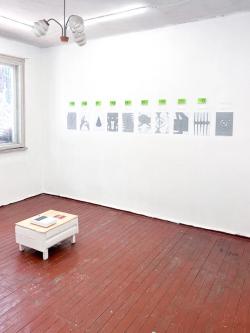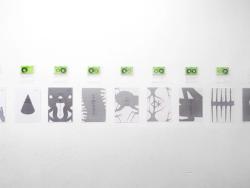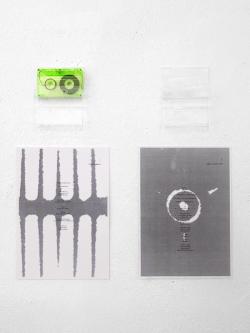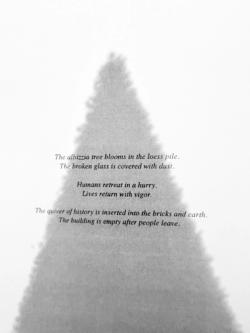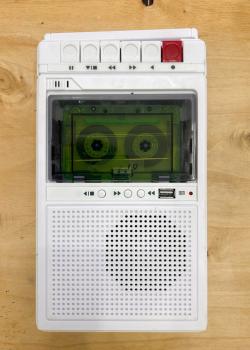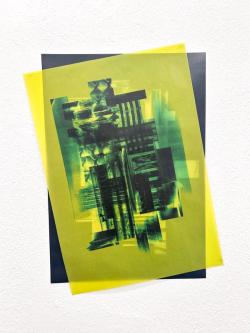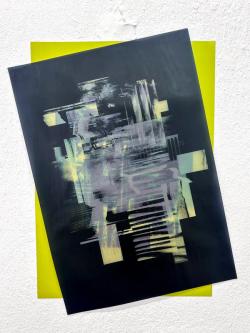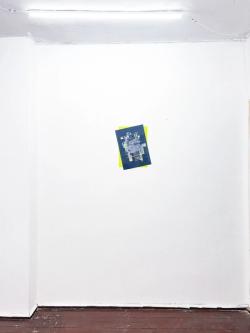Caiyun Chen
LURKKKKING
25.07. – 14.08.2025' /%3E%3C/svg%3E)
Lurking, 2025 Tape drive, tapes, a total of 600 minutes Variable size ' /%3E%3C/svg%3E)
Lurking, 2025 Tape drive, tapes, a total of 600 minutes Variable size ' /%3E%3C/svg%3E)
Lurking, 2025 Tape drive, tapes, a total of 600 minutes Variable size ' /%3E%3C/svg%3E)
Lurking, 2025 Tape drive, tapes, a total of 600 minutes Variable size ' /%3E%3C/svg%3E)
Lurking, 2025 Tape drive, tapes, a total of 600 minutes Variable size ' /%3E%3C/svg%3E)
Drifting Map, 2025 Digital printing Variable size ' /%3E%3C/svg%3E)
Drifting Map, 2025 Digital printing Variable size ' /%3E%3C/svg%3E)
Drifting Map, 2025 Digital printing Variable size
Exhibition at Stefan Stambolovo 36th Street
"I walked through fields, weedy paths, half-empty roads, and sound travels slower than it should. You start to notice things—how trees lean, how dust accumulates, how heat gathers at your waist. So I thought of 'Lurking', which is both a verb and a state, a state of sound and perception. It suggests a way of perception that is constantly brewing in the edges, shadows, and gaps."
The exhibition consists of two works created in parallel: "Lurking", a 600-minute sound archive composed mainly of tape loops; and "Drifting Map", a series of abstract images created through movement.
Those latent rhythms, unarranged sequences, and forgotten voices make sound a language container that can be reorganized. "Lurking" is a non-linear narrative sound archive installation composed of 10 chapters of fictional prose and poetry. The artist sampled the local environmental soundscape, language fragments and folk music during his residency in Bulgaria, deconstructed and reorganized them, and injected them into each tape. It is presented in an open structure, which is what happens when time folds itself and begins to resound. The work invites the audience to personally select a tape, insert it into the tape drive and play it. Fragments of environmental sounds, footsteps, mechanical noises, sounds, memories, landscapes and languages flowing under the surface are evoked one by one. The work does not set a fixed order, allowing chance and the audience's personal intuition to arrange the archive. Each playback is a time weaving composed by the audience themselves. The power of narration is no longer concentrated in the hands of the artist, but transferred to the decision and participation of each listener, and transformed into a co-generated writing.Why is sound not a kind of sculpture? The trajectory of sound is like an unpredictable time structure. The audio recorded in the tape will expand and wander in the space, echoing to the stairs, circling and extending to the window or the gaps in the texture. As a time-based art, "Lurking" accommodates the cracks in time and latent memories. It has no fixed boundaries. Sound becomes a container here, a porous sound sculpture. The tape, stairs, window sills, and air gaps constitute a nonlinear sound field, an experimental exploration of the boundaries between hearing and space. Sound is no longer just an object of hearing, but has become a sculptor of space, an evoker of emotions, and a device for summoning memories.
The image works in the exhibition continue my practice of "drifting" as a methodology - borrowing the concept of psychogeography proposed by Guy Debord, I conducted a series of non-purposeful walks and observations in the Vishovgrad area of Bulgaria, where the body became a tool for measuring the landscape, and memory and encounters became the starting point of the image. At that time, I was walking through the village, without a map or a destination, but walking intuitively, and the sound of the terrain. "Drifting Map" captures speed or moments, hesitation or vibration. These images are more like residues and shadows than direct images. I collect image fragments based on movement. This group of image works can be understood as a visual translation of spatial experience: a reinterpretation and rewriting on a two-dimensional plane. The boundaries of three-dimensional geography are deconstructed into emotional terrain in the image, no longer subject to functionality or objective coordinates, but slowly extending towards a poetic order. The images wander through the historical fragments of the place and the daily perception of the landscape. The map is no longer a tool for positioning, but an extension of the boundary between the body and daily experience, a nonlinear map shaped by rhythm and contingency.
The entire exhibition space is not a work of fixed shape, but a triggered state. In this state, we are both "lurkers" and "lurking" - the body, memory, and language are all in a critical floating state. Just like the word "Lurking" carries the pull of time and space: "It can be the moment when something is waiting for action, or it can be a certain emotion that is slowly generated in a hidden and unspoken period. So, you no longer try to retell this place, let the environment speak first, and let the terrain determine everything."
Caiyun Chen(b.2002) Shanghai, graduated from the Glasgow School of Art, MFA, 2024. Since 2018, Their work has included experimental video, installations, graphics, and electronic music. The current research focuses on image reconstruction, digital intervention, hyperimage analysis, intertextual writing and interimagery, visual power, identity issues and noise practices. Their current research delves into the complexities of image reconstruction and digital intervention, with a keen interest in how technology alters and reshapes our perception of images. They meticulously examine how images exert power and influence within society, breaking down and analyzing intricate visual systems that extend beyond the conventional boundaries of visual representation. In parallel, their work is deeply engaged with intertextual writing and interimagery—exploring how different forms of media and text interact, influence one another, and generate new meanings when combined. This interdisciplinary approach results in a seamless integration of textual and visual elements, fostering dialogues across various media platforms. A significant aspect of their work centers on the dynamics of visual power and identity. They frequently question how these elements are represented and perceived in contemporary society, particularly at the intersections of personal, cultural, and digital identities. Additionally, their practice includes noise experimentation, exploring the boundaries between sound, silence, and the disruptions that occur within this spectrum. By creatively utilizing sound and visual distortions, they aim to expand the limits of perception and challenge conventional narratives. Recent works have been shown at venues including VCAS (Vienna), New Glasgow Society (Glasgow), South Block Gallery (Glasgow), Ubox (Shanghai), Weland Foundation for The Third Pole (Lhasa, Tibet), DOC.Park (Guangzhou),The Alchemy Experiment(Glasgow). They also collaborate on club visuals, and queer community.
